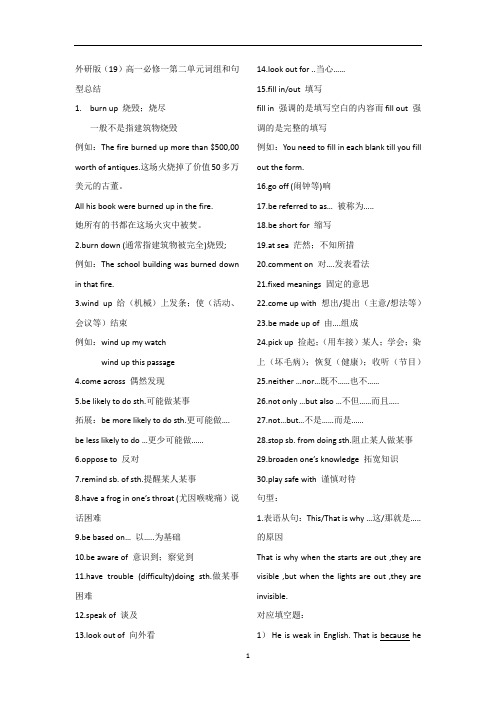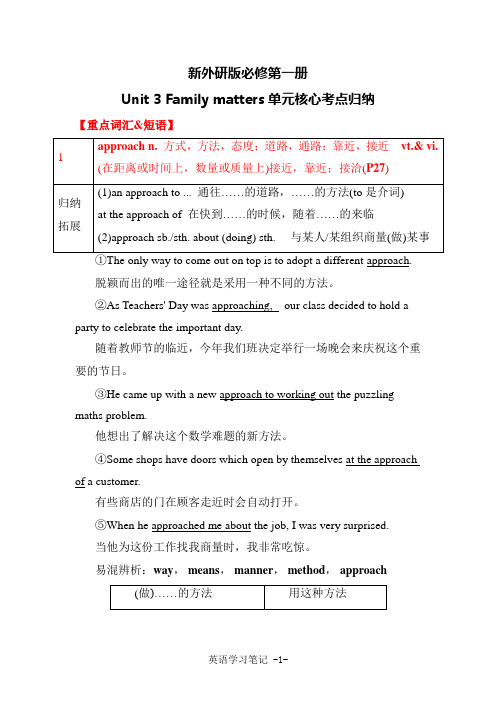高一英语必修一外研版每单元语法经典总结
- 格式:docx
- 大小:31.67 KB
- 文档页数:9

最新外研版高一英语必修一课本知识点梳理大全(全册共49页)外研版高一必修一Unit 1【教材同步一点通】◆【梳理整合】1.____________ adj. 热心的→____________ n. 热情;热忱2.____________ vt.使惊异→____________ adj. 令人吃惊的;令人惊讶的→____________ adj. 吃惊的;惊讶的3.____________ vt.使厌烦→____________ adj. 厌烦的;厌倦的→____________ adj. 令人厌烦的;使人厌倦的4.____________ vt.使尴尬;使窘迫→____________ adj. 尴尬的;难堪的;困窘的→____________ adj.令人尴尬的;令人难堪的5.____________ vt.使印象深刻→____________ n. 印象6.____________ n. 鼓励;激励→____________ vt.鼓励;激励7.____________ n. 享受;乐趣→____________ vt.享受;从……获得乐趣8.____________ vt.理解;明白→____________ vt.误解→____________ n. 误解[来源学科网ZXXK]9.____________ vt.使失望→____________ adj. 失望的→____________ adj. 令人失望的10.____________ vi.消失→____________ vi.出现语境记单词1.Professor Watson is leaving the ____________(学术的)world to take a job in industry.2.I'm an ____________(热心的)admirer of Super Dan,who won the London Olympic gold in badminton.3.Students should pay more attention to the reading ____________(理解)and writing in their English learning.4.The stepmother's ____________(行为)towards Lily shows that she likes her very much.5.I keep in touch with many of my ____________(以前的)classmates after leaving school.6.The plane ____________(消失)behind a cloud.7.He finally found a job in a department store and worked as a shop ____________(助手).8.Please don't feel ____________(难堪的)when someone corrects your mistakes.9.I'm t rying to find a better learning ____________(方法)in order to improve my English.10.Chinese army has shown its ____________(态度)that Huangyan Island is part of China's territory.短语回顾1.____________ 和……相似2.____________对……态度;看法3.____________ 一点也不像;根本不像4.____________ 换句话说2.bored adj . 厌烦的;厌倦的 bore vt.使厌倦;使乏味。

外研版选择性必修第一册全册知识点提炼Unit 1 Laugh out loud ............................................................................................................... - 1 - Unit 2 Onwards and upwards ................................................................................................. - 13 - Unit 3 Faster, higher, stronger ................................................................................................ - 26 - Unit 4 Meeting the muse ....................................................................................................... - 38 - Unit 5 Revealing nature .......................................................................................................... - 50 - Unit 6 Nurturing nature ......................................................................................................... - 62 -Unit 1 Laugh out l oud1.approach v.接近;靠近n.方法;途径approach to...……的方法2.curly adj.卷曲的3.the waiting area等候区4.atmosphere n.氛围;大气层5.boredom n.枯燥bored adj.感到枯燥的boring adj.令人枯燥的6.look through 浏览;看穿7.previously adv.先前地;以前地fort v.安慰comfortable adj.舒适的9.scene n.场景;现场on the scene在现场10.spot v.发现11.on-duty 值班的;当班的12.fall off从……跌落13.spend some time doing sth.花费时间做某事14.in pain在痛苦中15.chemical n.化合物16.make people feel better是“make+宾语+宾补”结构。

外研版(19)高一必修一第二单元词组和句型总结1.burn up 烧毁;烧尽一般不是指建筑物烧毁例如:The fire burned up more than $500,00 worth of antiques.这场火烧掉了价值50多万美元的古董。
All his book were burned up in the fire.她所有的书都在这场火灾中被焚。
2.burn down (通常指建筑物被完全)烧毁;例如:The school building was burned down in that fire.3.wind up 给(机械)上发条;使(活动、会议等)结束例如:wind up my watchwind up this passagee across 偶然发现5.be likely to do sth.可能做某事拓展:be more likely to do sth.更可能做…. be less likely to do …更少可能做……6.oppose to 反对7.remind sb. of sth.提醒某人某事8.have a frog in one’s throat (尤因喉咙痛)说话困难9.be based on… 以…..为基础10.be aware of 意识到;察觉到11.have trouble (difficulty)doing sth.做某事困难12.speak of 谈及13.look out of 向外看14.look out for ..当心……15.fill in/out 填写fill in 强调的是填写空白的内容而fill out 强调的是完整的填写例如:You need to fill in each blank till you fill out the form.16.go off (闹钟等)响17.be referred to as… 被称为…..18.be short for 缩写19.at sea 茫然;不知所措ment on 对….发表看法21.fixed meanings 固定的意思e up with 想出/提出(主意/想法等)23.be made up of 由….组成24.pick up 捡起;(用车接)某人;学会;染上(坏毛病);恢复(健康);收听(节目)25.neither …nor…既不……也不……26.not only …but also …不但……而且…..27.not…but…不是……而是……28.stop sb. from doing sth.阻止某人做某事29.broaden one’s knowledge 拓宽知识30.play safe with 谨慎对待句型:1.表语从句:This/That is why …这/那就是…..的原因That is why when the starts are out ,they are visible ,but when the lights are out ,they are invisible.对应填空题:1)He is weak in English. That is because hedoesn’t work hard.2)She is always late for work. That is why she will be fired soon.3)The reason is that she hasn’t finished the work in time.。

新外研版必修第一册Unit 3 Family matters单元核心考点归纳【重点词汇&短语】The only way to come out on top is to adopt a different approach.脱颖而出的唯一途径就是采用一种不同的方法。
②As Teachers' Day was approaching, our class decided to hold a party to celebrate the important day.随着教师节的临近,今年我们班决定举行一场晚会来庆祝这个重要的节日。
③He came up with a new approach to working out the puzzling maths problem.他想出了解决这个数学难题的新方法。
④Some shops have doors which open by themselves at the approach of a customer.有些商店的门在顾客走近时会自动打开。
⑤When he approached me about the job, I was very surprised.当他为这份工作找我商量时,我非常吃惊。
易混辨析:way, means, manner, method, approachI am so tired that I can't focus on anything today.我今天太累了,集中不了精力做任何事。
②If we find those materials interesting, we'll focus our attention on them for long.如果我们发现那些材料有趣,我们的注意力就会长时间集中在它们身上。
③You can't take a good photograph unless the object is in focus.只有对准焦距你才能拍出好照片。

外研版高中英语必修1重要知识点归纳外研版高中英语必修1是我们学习英语的重要教材,该教材覆盖了许多重要的知识点,本文将对其中一些关键知识点进行归纳总结,以帮助大家更好地掌握这些知识。
一、重要的语法知识点1. 一般现在时:用于描述客观事实、经常性行为或习惯,句子中的主语为第三人称单数时,动词需加s或es结尾。
2. 一般过去时:用于描述过去的事情或经过的经历,动词需要变为过去式,常见的过去式有加-ed或变化不规则的形式。
3. 现在进行时:表示正在进行的动作,主要由be动词+动词的现在分词构成。
4. 一般将来时:表示将来发生的动作,句子中使用will或be goingto来表示。
5. 名词性从句:将一个句子中的名词用另一个句子来替代,从句开头的词有what, where, when, why, how等。
6. 定语从句:用于修饰某个名词,关系代词通常有that, which, who 等。
二、重要的词汇知识点1. 形容词和副词的比较级和最高级:用于描述人或物的性质或程度。
2. 数词:描述数量和顺序的词,包括基数词和序数词。
3. 复合词:由两个或多个词组合而成,具有新的意义,如blackboard, football等。
4. 介词短语:描述位置、方向、时间等,如in front of, on the left等。
5. 动词短语:由动词和副词或介词组合而成,表示一个动作或状态,如look after, think of等。
三、重要的阅读技巧1. 找出关键信息:通过快速阅读文章,找出文章的主题、关键词和关键句,了解文章的大意。
2. 掌握词汇技巧:通过上下文推测词义,了解文章中不熟悉的词汇的含义。
3. 理解句子结构:分析句子的结构,理解句子中各个成分之间的关系,帮助理解句子的含义。
4. 注意段落结构:理解每个段落的主题,通过段落之间的联系理解文章的结构和内容。
5. 提高阅读速度:通过多进行阅读训练,提高阅读速度和阅读理解能力。

外研版高中英语必修一语法英语必修一MODULE 1重要知识点1、重点词组换句话说in other words期待;盼望look forward to doing sth.寻找look for对…印象深刻be impressed with 与…不同be different from 在……开始的时候at the start of 在……结束的时候at the end of被(划)分成……be divided into2.语法基础主语:句子或者句意的主要人物或事物,一般在句首。
主语的成分有名词(如boy),主格代词(如you),动词不定式(由to+动词原形构成),动名词(如果一个动词加上了ing变成了名词,那么这个词称动名词)等。
谓语:谓语由动词构成,是英语时态、语态变化的主角,一般在主语之后。
及物动词vt.,不及物动词vi.。
及物动词可直接接宾语;不及物动词后不能直接接宾语。
若要接宾语,必须先在其后添加上某个介词,如in,to,of ,at。
He reached Paris the day before yesterday.This is the room where I once lived.Please hand me the book over there.I went to school yesterday.宾语:宾语分为直接宾语和间接宾语两大类,其中直接宾语指动作的直接对象,间接宾语说明动作的非直接,但受动作影响的对象。
一般而言,及物动词后面最少要有一个宾语,而该宾语通常为直接宾语,有些及物动词要求两个宾语,则这两个宾语通常一个为直接宾语,另一个为间接宾语。
例:The boy needs a pen.I teach him English.定语:对主语或者宾语的修饰。
汉语中常用“……的”表示。
主要有形容词此外还有名词、代词、数词、介词短语、动词不定式(短语)、分词、定语从句或相当于形容词的词、短语或句子都可以作定语。
简单句的五种基本结构以及句子成分了解中英文思维的差别中文重“意”,英文重“形”共同点:陈述对象+陈述内容即主+ 谓(主干)建议:在复习复杂的难句结构时,首先要找到句子的谓语,包括主句的谓语以及各个从句的谓语。
Another way of naming places is naming them after other places. Perhaps they were named to promote friendships between the two places or it could be that the people who used to live there were originally from the places that the roads were named after.(另一个命名地方的方式是以其他地方命名。
也许他们的名字是为了促进两地之间的友谊,也可能是原来住在那里的人是来自于道路得名的地方。
)英语句型的结构:主干+其他成分(从句,介短,非谓,时状)A man was standing at a bus stop eating fish and chips. An old lady and herlittle white dog stood next to him. The dog, excited by the smell of the fish and chips, started to bark and jump up on the man’s leg.“Do you mind if I throw him a bit?”“Not at all,” she said. “Go ahead.”So the man picked up the little dog and threw it over a wall.简单句的五种基本结构以及句子成分句型一、主谓成分一:主语一个句子所叙述的主体,一般位于句首。
Unit 1 A new start1.What was your first impression of your new school?你对新学校的第一印象如何?【词汇精讲】impression是名词,意为“印象;感想”。
2.Turning around,I saw a white-haired man.我转过身来,看见一位白发男子。
【词汇精讲】句中的turn around是动词短语,意为“转身”,是一个不及物动词短语。
3.With butterflies in my stomach,I breathed deeply.心里七上八下,我深吸了一口气。
4.I looked at them in panic.我惊慌地看着他们。
5.Although I was embarrassed,his words made me a lot more relaxed.虽然我很尴尬,但他的话让我放松了很多。
6.I was looking at the photos on the noticeboard when I heard a voice behind me.我正在看布告栏上的照片,突然听到身后有个声音。
【句式剖析】这是一个sb.was/were doing sth.when...句型,其中的when 是并列连词,意为“在那时”,相当于and then或and at the same time。
【句式拓展】when作并列连词时常用于以下句型中:be doing sth.when...正在做……这时……be about to do sth.when...=be on the point of doing sth.when...正要做……这时……had just done sth.when...刚做了……这时……We were about to set out when it began to rain.=We were on the point of setting out when it began to rain.我们正要出发,这时天开始下雨。
外研版高一英语必修一知识点总结外研版高一英语必修一知识点总结高一的学生在学习必修一的英语知识时,一定要认真,因为这个阶段接触的每个知识点都是重点,都需要理解明白。
下面是店铺为大家整理的高一英语必修一知识归纳,希望对大家有用!高一英语必修一语法知识一、实词1.名词(nouns)n.:名词是词性的一种,也是实词的一种,是指代人、物、事、时、地、情感、概念等实体或抽象事物的词。
名词可以独立成句。
在短语或句子中通常可以用代词来替代。
名词可以分为专有名词(Proper Nouns)和普通名词(Common Nouns),专有名词是某个(些)人,地方,机构等专有的名称,如Beijing,China等。
普通名词是一类人或东西或是一个抽象概念的名词,如:book,sadness等。
2.代词(pronoun)pron.:代词是代替名词的一种词类。
大多数代词具有名词和形容词的功能。
英语中的代词,按其意义、特征及在句中的作用分为:人称代词、物主代词、指示代词、反身代词、相互代词、疑问代词、关系代词、连接代词和不定代词九种。
3.数词(numeral)Num.:表示“多少”和“第几”的词,叫数词。
其用法相当于名词或者形容词。
数词分为基数词和序数词两种。
4.形容词(adjective)adj.或a.;很多语言中均有的主要词类中的一种。
主要用来修饰名词的词,表示事物的特征。
形容词用来修饰名词或代词,表示人或事物的性质、状态,和特征的程度好坏,与否。
5.副词(adverb)adv.:是一种用来修饰动词、形容词、全句的词,说明时间、地点、程度、方式等概念的词。
副词是一种半虚半实的词。
副词可分为:时间副词、地点副词、方式副词、程度副词、疑问副词、连接副词、关系副词、频率副词和说明性副词等。
6.动词(Verb)v.:动词,就是用来形容或表示各类动作的词汇。
基本上每个完整的句子都有一个动词,要表示第二个动作时可使用不定词、动名词、对等连接词、从属连接词或增加子句等方法连结。
高一外研版必修一unit1知识点总结高一外研版必修一Unit 1知识点总结在高中英语课程中,Unit 1是我们所学的第一个单元,也是我们对英语语言和文化进行初步了解的起点。
本文将对高一外研版必修一Unit 1的知识点进行总结,不仅让我们回顾所学内容,更能帮助我们深入理解英语的运用和表达。
单词记忆是英语学习的基础。
在Unit 1中,我们学习了许多重要的单词,如environment、automobile、reduce、waste等。
环境保护成为当今社会关注的热点话题,学习这些与环境相关的单词,可以让我们更好地了解和表达环保的观点。
同时,我们还学习到了一些文化背景下的词汇,比如pandas、volcano、festival等,通过学习这些单词,我们了解了世界各地的自然风光和传统文化。
除了单词记忆,对句子结构和语法的掌握也是英语学习不可或缺的部分。
在Unit 1中,我们学习了一些重要的语法结构,如主谓一致、疑问句和祈使句等。
主谓一致是英语语法中的基本规则,它要求主语和谓语在人称和数上保持一致。
疑问句是用来提问的句子结构,通常以助动词或疑问词开头。
祈使句是一种用于表达请求、建议或命令的句子,它常常省略了主语。
通过学习和掌握这些语法结构,我们能够更准确地表达自己的意思,并更好地理解他人的表达。
在Unit 1中,我们还学习了一些重要的语篇和段落结构。
语篇结构是指文章或段落的组织方式,常见的有时间顺序、空间顺序和因果关系等。
了解这些结构可以帮助我们更好地阅读和理解文章。
段落结构是指文章中的段落组织方式,通常由主题句和支持细节组成。
通过学习段落结构,我们能够更好地组织和表达我们的观点。
除了语言知识和结构,阅读理解能力也是英语学习的重要部分。
在Unit 1中,我们学习了一些与环境相关的文章,并进行了相关的阅读理解训练。
通过阅读这些文章,我们了解了环境问题的严重性以及保护环境的重要性。
我们还学习了一些阅读策略,如推测词义和理解上下文等。
4 Module 1 My First Day at Senior High Grammar 1: 一般现在时和现在进行时
般 现 在 时
表示现在习惯或反复发生的动作或存 在的状态 ,常与 usually 、 always 、 Seldom、sometimes、often、frequently 、 every day 、 every week 、 (year morning)on Sunday 等时间状语连用。
1.The students often do their experiment in the laboratory. 2.We always care for each other and help each other. 3.I am used to listening to the weather report every morning. 4.He sometimes stays up till midnight to catch up with others. 5.Do you usually go to school on Sunday.
表示主语现在的特征 、性格和状态 1、 She is always ready to help others. 2、China is a developing country which belongs to the third world. 3、 ---Do you sing? –A little.
表示客观规律、正确事实或科学真理、 格言以及其他不受时间限制的客观存 在。
1、All the living things on the earth depend on the sun. 2、 Knowledge comes only from practice. 3、 Unpleasant advice ,like bitter medicine ,has welcome effect. *Our teacher told us the earth goes round the sun. 在由连词 if 、unless 、before 、 as soon as when 、 once、 however 等引起 的时间(条件、让步)状语从句,需 用一般现在时,表示将来。
1、 I 'll call on you unless it rains the day after tomorrow. 2、 Even if it rains tomorrow, the sports meet will take place. 3、 We will start as soon as you are ready. 4、However much advice you give him, he will do exactly what he wants. 表示安排或计划要做的动作(有时间 状语)限于 begin 、come、 leave、 go、 arrive、start、stop、open、close、return 等
1、The film starts at seven o 'clock this evening. 2、 The plane takes off at 5:00a.m. 3、 We leave for Beijing next Friday.
现 在 进
用法 例示 表示现在(说话的瞬间)正在进行或发生的动作 1、 Look, the boy is
dozing off. 2、Look! The monkey is climbing the banana tree. 3、 I haven 't accepted his suggestion yet. I 'm still considering it.
表示当前一段时间内的活动或现阶段正在进行的动作(说话时 动作不一定正在进行) 1 、 How are you
getting along with your English these day. 2、 We are going over the grammar learned before at present. 3、 W are preparing for the meeting to be 行 时 held next Friday now.
表示说话人现在对主语的行为表赞叹,厌恶等,常与 always\constantly\continually 等副词连用
1 、 He is always
thinking of others.(表 赞许) 2、 He is constantly leaving his things about.(表不满) 3、 The children are always making trouble.(表厌恶) 4 、 She is always asking the same question.(表厌恶) 5 、 You are always changing your mind. (表抱怨)
表示在最近计划或安排要进行的动作,常限于 go\come\leave\start\arrive\return\work\sleep\stay\do\have\wear 等 表移动,方向的动词
1、 He is starting the work in a few minutes. 2、 A foreign guest is giving a lecture in English this afternoon. 3、 He is leaving for Beijing tomorrow afternoon. 4、 He is coming to see you next month. 5、 He is staying with us for a few weeks next year. Grammar 2: 分词形容词 英语中有些形容词是由动词的 ---ing 构成的 (通常表示事物给人的感觉, 意为“是令人 感到 ⋯ ..的”),有些形容词是由动词的 ed 构成的(通常表示人对事物的感觉,意为 “对 ⋯⋯感到⋯⋯ 的”)。前者表示主动的意义,后者表示被动的意义。由于他们的形式 与现在分词和过去分词完全一样, 故又称它们为 “ 分词形容词” ,在句中做表、 定、状、
Module 2 My New Teachers Grammar :后接 V-ing 的动词 (1)英
语中有很多的动词后只跟动名词作宾语:如 advise, consider, admit, appreciate, mind , avoid, excuse, delay, imagine, deny, enjoy, keep(on), practice, resist, escape , risk , put off, explain, quit( 停止 ), tolerate, pardon, allow, forbid, miss (错过 ) , suggest, advise, recommend, finish, envy, can't help
补等成分。常见的有: amazing --- amazed frighting ----- frightened boring- ---bored moving ----- moved disturbing - disturbed tiring ---- tired
amusing ---- amused confusing-- confused discouraging-- discouraged
astonishing -- astonished disappointing — disappointed encouraging – ( 2) 有一类动词后直接跟动名词形式作宾语;如果后面跟名词、代词加宾补, 则宾 补用不定式‘这类常见的可记忆为“阿福的帽子” :FU 'S CAP : allow, forbid, understand, suppose, consider, advise, permitted eg: ① We don ' t allow using mobile phone here. ② We don't allow him to use mobile phone here. ③ He is not allowed to use mobile phone here. (3) “动词 + 介词”构成的短语, 其后往往跟动名词作宾语。 尤其是含有介词 “to “的 动名词短语;常见的有: be used to 习惯于, devote oneself to 致力于; lead to导致;see to注意,处理 pay attention to ; get down to ; stick to; get accustomed to ; look forward to (4) “what \ how about + v-ing ”常用来征询意见,意为“。 。。怎么样? eg: What about going on a picnic? (5)有些动词后跟不定式与动名词的意义差别较大,高考出现频率较大:
forget to do sth doing sth remember to do sth doing sth
regret to do sth doing sth op to do sth doing sth
mean to do sth doing sth try to do sth (努力\ 试图做 sth)
doing sth ( 尝试做某事 )
go on to do sth doing sth (with sth ) can't help to do sth doing sth
【注】: remember, forget, regret 后跟 doing 与跟 having done 的意思一样。 (6)动名词的复合结构:动名词的前面可以有自己的逻辑主语构成动名词的复合结构。 其结构由物主代词或人称代词 (宾语)、名词所有格或普通格加动名词构成 , 在句子开头 必须用名词所有格或物主代词。 eg:① Tom's doing sth 可作主、宾、表 His doing sth ② Tom doing sth 可作主、表 Him doing sth
Module 3 My First Ride on a Train Grammar 1: 动词的过去分词 ①及物动词的过去分词作定语表示被动或完成,或两者兼而有之 eg: a respected teacher a broken cup ②不及物动词的过去分词作定语只表示完成的含义 eg: He is a retired worker. ③V-ed 形式的分词形容词作定语说明所修饰的名词的状态, 容词 eg: a surprised look disapointed children ④过去分词可以和形容词或副词一起构成合成形容词一起做前置定语 eg: a highly-developed industry a widely-used language ⑤过去分词短语作后置定语放在所修饰词的后面,逻辑上相当于一个被